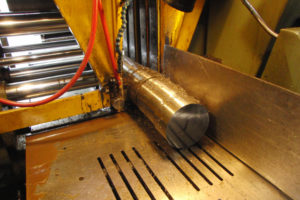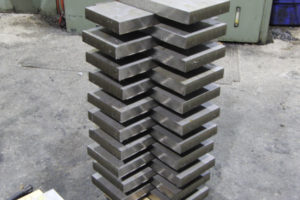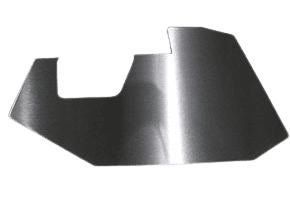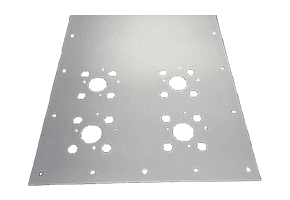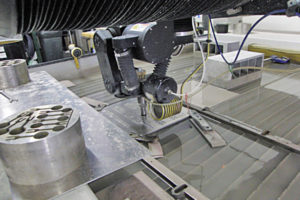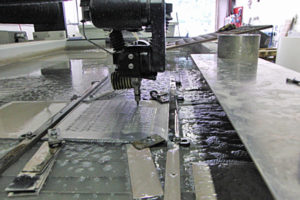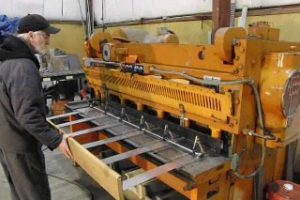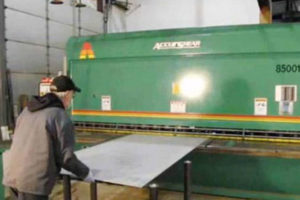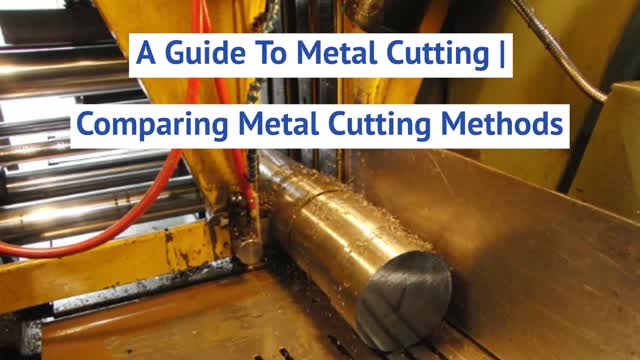Metal cutting is a manufacturing process in which a larger piece of material is separated into smaller pieces or parts. There are numerous metal cutting methods available, each of which offers distinct benefits and limitations that make it suitable for different manufacturing projects. Below, we highlight some of the most common, outlining how they work, what advantages and disadvantages they have, what types of metals they cut, and what applications they are used in to help industry professionals choose the best method for their needs:
An Overview of Sawing/Saw Cutting
Sawing—also sometimes referred to as a saw cutting—is a cutting method that utilizes a saw blade—i.e., a tool with sharp metal teeth—to cut material into more manageable sections or specific shapes and sizes. The primary types of saw cutting employed by manufacturers are circular saw cutting and band saw cutting. Circular saw cutting uses a circular blade that cuts material as it spins, while band saw cutting uses an extended straight blade that provides continuous, uniform action.
Advantages Offered
This cutting method offers several advantages over some of the other metal cutting methods. For example, it allows for close tolerance cutting, which reduces the amount of waste generated during cutting operations. Additionally, it offers both fast cutting speeds and high cut quality, which results in quicker turnaround without a need for further finishing procedures. Altogether, these result in lower overall project costs for some applications.
Materials Used
Sawing accommodates a variety of metals, including, but not limited to, aluminum, brass, bronze, copper, high-temperature alloys, nickel alloys, stainless steel, and titanium. It can cut these materials in bar, plate, pipe and tube form. However, it is best suited for cutting materials with greater thicknesses or varying cross-sections since the equipment can have difficulty keeping thin, flat material stable as it is cut.
Industries Served
Some of the industries that regularly rely on saw cutting to help produce their parts and products include aerospace, architectural, biotechnology, chemical, food processing, marine, packaging, and pharmaceutical.
An Overview of Laser Cutting
Laser cutting is a cutting method that employs high-powered, focused beams of light to heat, melt, and cut through material without touching it directly. It can utilize a variety of cutting and removal mechanisms to suit different materials and cutting requirements. In addition to separating larger pieces into smaller pieces or parts, the laser technology can also be used to etch or engrave materials for functional and aesthetic purposes.
Advantages Offered
Today, many laser cutting technologies come with computerized controls. These systems help position and move the laser across the material precisely and accurately, ensuring the cut piece has the proper shape and size. In addition to high cutting precision and accuracy, other advantages laser cutting offers over some of the other metal cutting methods include smaller maintenance and replacement costs, lower chance of material contamination, and greater workplace safety.
Materials Used
This metal cutting method can be used on a wide range of materials. It is often employed to cut plates and sheets made from aluminum, brass, copper, nickel, stainless steel, and titanium. It is not suitable for use with heat-sensitive or reflective materials since the former may deform while the latter may cause damage to the equipment.
Industries Served
Laser cutting finds application in the manufacturing operations of a wide range of industries. Some of the industries that regularly use it include aerospace, architectural, biotechnology, chemical, food processing, marine, packaging, and pharmaceutical.
An Overview of Waterjet Cutting
Waterjet cutting is a metal cutting method that utilizes pressurized water to cut material into the desired shape and size. The high-pressure streams of water—i.e., waterjets—can also have added abrasives, such as aluminum oxide or garnet, to aid the cutting process, ensuring a complete cut through even very thick or very hard materials.
Advantages Offered
Waterjet cutting is a cold cutting method, meaning it does not require a material to be heated or stressed by machinery. As a result, it generates a smaller heat affected zone (HAZ) during cutting operations, which reduces the risk of material thermally distorting. Additionally, compared to laser cutting, it cuts thicker materials to tighter tolerances and produces less slag byproducts.
Materials Used
This metal cutting method works well with a variety of materials, such as aluminum, brass, copper, nickel, steel, and titanium. It can be used to cut plates and sheets up to 6 inches in thickness.
Industries Served
Waterjet cutting can make 2D and 3D cuts, depending on the equipment. This quality allows manufacturers to make simple and complex components for various industries. Examples of waterjet cut parts and products include engines, turbine blades, and control panels for the aerospace industry and pipes and pumps for the marine industry.
An Overview of Shearing
Shearing is a metal cutting method that uses a moving upper blade and a stationary lower blade that are slightly offset from one another to cut material. As the upper blade descends, it pushes the material down on the lower blade. The pressure exerted deforms the material, eventually causing it to strain and give way. This forms the cut.
Advantages Offered
Compared to other cutting methods, shearing is much more versatile. In addition to cutting, shearing machines can also be used to bend, punch, and press metal materials. The process also produces virtually no waste since no chips are generated during cutting operations, which can help reduce overall material costs.
Materials Used
This cutting method is best suited for plate and sheet materials. Thick materials may require too much force to cut, while hollow materials may deform when cut. Typical materials used include aluminum, brass, bronze, copper, nickel, stainless steel, and titanium.
Industries Served
Sheared metal components are found in various industries. Examples include aircraft engines, discs, pipes, pumps, rings, and tubing.
Custom Metal Cutting Services from AAA Metals
Whether you need saw cutting, laser cutting, waterjet cutting, or shearing services for your project, AAA Metals has got your back! We can cut a broad selection of metals into various shapes, sizes, and quantities to exacting specifications. To learn more about our cutting capabilities and how to determine which one is right for you, contact us today. To discuss your cutting requirements with one of our experts, request a quote.


